
Stationery refers to commercially manufactured writing materials, including cut paper, envelopes, writing implements, continuous form paper, and other office supplies. Stationery includes materials to be written on by hand or by equipment such as computer printers.

A hole punch, also known as hole puncher, or paper puncher, is an office tool that is used to create holes in sheets of paper, often for the purpose of collecting the sheets in a binder or folder. A hole punch can also refer to similar tools for other materials, such as leather, cloth, or sheets of plastic or metal.

A fastener or fastening is a hardware device that mechanically joins or affixes two or more objects together. In general, fasteners are used to create non-permanent joints; that is, joints that can be removed or dismantled without damaging the joining components. Steel fasteners are usually made of stainless steel, carbon steel, or alloy steel.
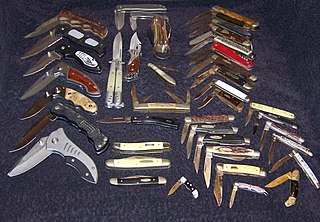
A pocketknife is a knife with one or more blades that fold into the handle. They are also known as jackknives (jack-knife), folding knives, EDC knife, or may be referred to as a penknife, though a penknife may also be a specific kind of pocketknife. A typical blade length is 5 to 15 centimetres.

The Army Combat Uniform (ACU) is the current combat uniform worn by the United States Army, U.S. Air Force, and U.S. Space Force. Within U.S. Air Force and U.S. Space Force, it is referred to as the OCP Uniform, rather than the Army Combat Uniform.

Ring binders are large folders that contain file folders or hole punched papers. These binders come in various sizes and can accommodate an array of paper sizes. These are held in the binder by circular or D-shaped retainers, onto which the contents are threaded. In North America, the rings themselves come in a variety of sizes, including 0.5, 1, 1.5, and 2 inches, though other sizes are also available. The rings may be secured by lever arch mechanisms or other securing systems, or may be spring-loaded. The binders themselves are typically made from plastic with metal rings. Early designs were patented during the early 1890s to the early 1900s.
A loose leaf is a piece of paper of any kind that is not bound in place, or available on a continuous roll, and may be punched and organized as ring-bound or disc-bound. Loose leaf paper may be sold as free sheets, or made up into notepads, where perforations or glue allow them to be removed easily. "Leaf" in many languages refers to a sheet or page of paper, as in Folio, as in feuille de papier (French), hoja de papel (Spanish), foglio di carta (Italian), and ルーズリーフ.

A manila folder is a file folder designed to contain documents, often within a filing cabinet. It is generally formed by folding a large sheet of stiff card in half. Though traditionally buff, sometimes other colors are used to differentiate categories of files.
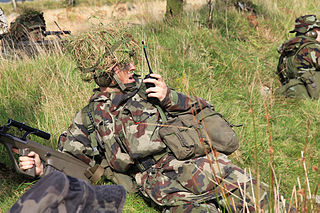
Personal Load Carrying Equipment (PLCE) is one of several tactical webbing systems of the British Armed Forces. Dependent upon the year of design, and the decade of introduction, the webbing system was named and is commonly referred to as the 85 Pattern, the 90 Pattern or the 95 Pattern webbing.
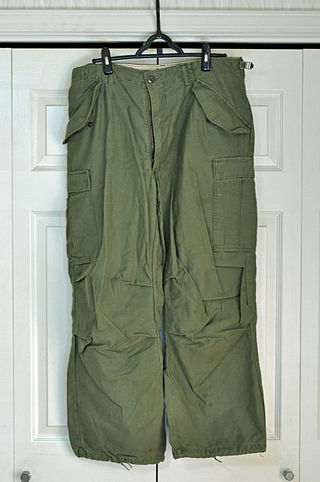
Cargo pants or cargo trousers, also sometimes called combat pants or combat trousers after their original purpose as military workwear, are loosely cut pants originally designed for rough work environments and outdoor activities, distinguished by numerous large utility pockets for carrying tools.
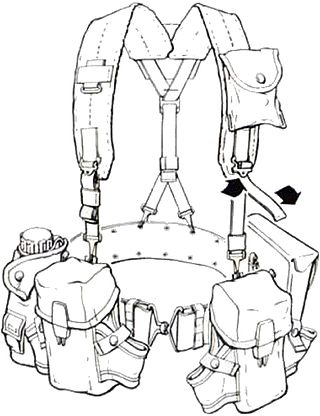
The All-Purpose Lightweight Individual Carrying Equipment (ALICE) is a set of load-carrying equipment adopted as United States Army Standard A on 17 January 1973 to replace the M-1956 Individual Load-Carrying Equipment (ILCE) and M-1967 Modernized Load-Carrying Equipment (MLCE). Although since superseded by MOLLE, ALICE gear is still in some limited use with the U.S. Army National Guard, State Guard, also some ground units of the Navy and Air Force.
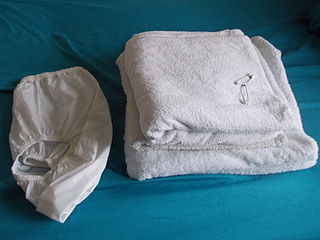
A cloth diaper or a cloth nappy, also known as reusable diaper or reusable nappy, is a diaper made from textiles such as natural fibers, human-made materials, or a combination of both. Cloth diapers are in contrast to disposable diapers, made from synthetic fibers and plastics. They are often made from industrial cotton which may be bleached white or left the fiber's natural color. Other natural fiber cloth materials include wool, bamboo, and unbleached hemp. Human-made materials such as an internal absorbent layer of microfiber toweling or an external waterproof layer of polyurethane laminate (PUL) may be used. Polyester fabrics microfleece or suedecloth are often used inside cloth diapers as a "stay-dry" wicking liner because of the non-absorbent properties of those synthetic fibers.
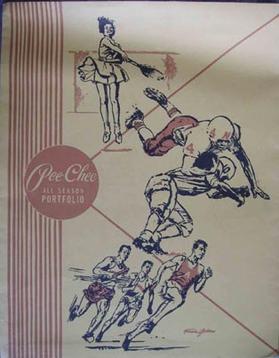
The Pee-Chee All Season Portfolio is an American stationery item that achieved popularity in the second half of the 20th century. It is commonly used by students for storing school sheets. The folder, which was originally produced solely in a peach-yellow tone, was first manufactured in 1943 by the Western Tablet and Stationery Company of Kalamazoo, Michigan. Pee-Chees were later produced by the MeadWestvaco Corporation.

In ice hockey, players use specialized equipment both to facilitate the play of the game and for protection as this is a sport where injuries are common, therefore, all players are encouraged to protect their bodies from bruises and severe fractures.
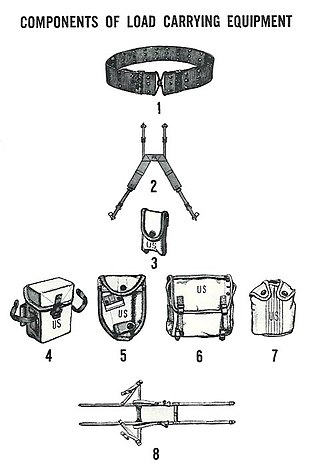
The M-1956 Load-Carrying Equipment (LCE), also known as the Individual Load-Carrying Equipment (ILCE), was developed by the U.S. Army and first issued in the early 1960s. The M-1956 LCE was designed to replace the M-1945 Combat Pack, the M-1923 cartridge belt, the M-1936 pistol belt and the M-1937 BAR magazine belt. The M-1956 LCE was designed to be quickly configured, using no tools, to accommodate various mission and ammunition loads. The M-1956 LCE remained in service through the 1980s and set the standard for future United States military load-carrying equipment.

A police duty belt is a belt, typically constructed of nylon or leather used by police, prison and security officers to carry equipment easily in a series of pouches attached to the belt, in a readily-accessible manner, while leaving the hands free to interact. This belt can carry any number of useful items, ranging from handcuffs to guns.

A kneeboard is an accessory with various types of clips or mounts to hold objects for pilots during flight.
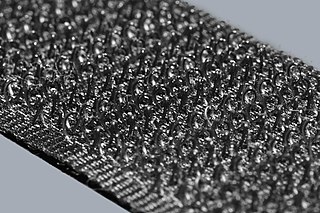
Hook-and-loop fasteners, hook-and-pile fasteners or touch fasteners, are a method for allowing two surfaces to be repeatedly fastened and unfastened, useful for clothing or other purposes. The fastener consists of two components: typically, two lineal fabric strips which are attached to the opposing surfaces designed to be fastened together. The first component features tiny hooks and the second component features smaller loops; When the two are pressed together, the hooks catch in the loops and the two pieces fasten or bind temporarily. When separated, which can be done by pulling or peeling the two surfaces apart, the strips make a distinctive ripping sound.
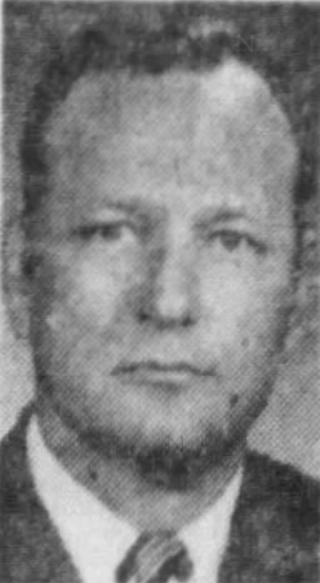
Ernest Bryant "Crutch" Crutchfield, was an American executive. He was perhaps best known for his invention of the "Trapper Keeper", a type of loose-leaf ring binder geared to students.
South park - Series 04, episode 12.
Cartman gets a Trapper Keeper, and the future of the world is at risk, in an episode not too dissimilar to Terminator.


















